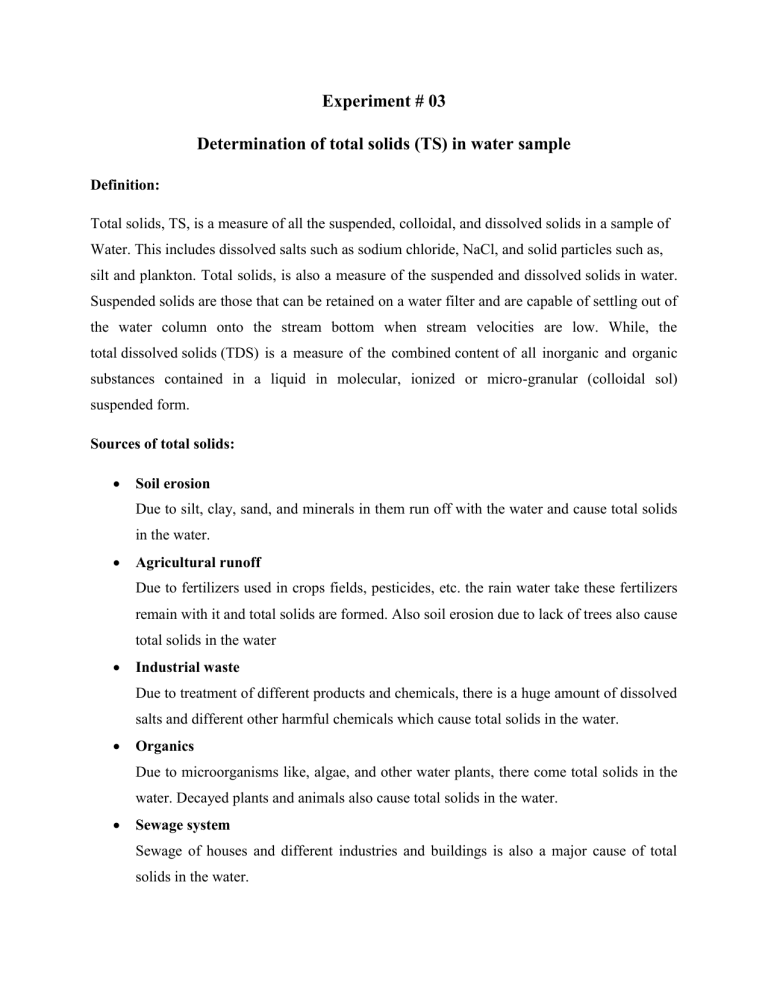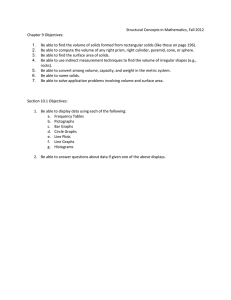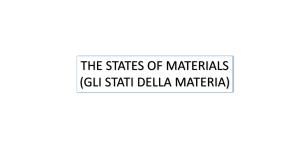
Experiment # 03 Determination of total solids (TS) in water sample Definition: Total solids, TS, is a measure of all the suspended, colloidal, and dissolved solids in a sample of Water. This includes dissolved salts such as sodium chloride, NaCl, and solid particles such as, silt and plankton. Total solids, is also a measure of the suspended and dissolved solids in water. Suspended solids are those that can be retained on a water filter and are capable of settling out of the water column onto the stream bottom when stream velocities are low. While, the total dissolved solids (TDS) is a measure of the combined content of all inorganic and organic substances contained in a liquid in molecular, ionized or micro-granular (colloidal sol) suspended form. Sources of total solids: Soil erosion Due to silt, clay, sand, and minerals in them run off with the water and cause total solids in the water. Agricultural runoff Due to fertilizers used in crops fields, pesticides, etc. the rain water take these fertilizers remain with it and total solids are formed. Also soil erosion due to lack of trees also cause total solids in the water Industrial waste Due to treatment of different products and chemicals, there is a huge amount of dissolved salts and different other harmful chemicals which cause total solids in the water. Organics Due to microorganisms like, algae, and other water plants, there come total solids in the water. Decayed plants and animals also cause total solids in the water. Sewage system Sewage of houses and different industries and buildings is also a major cause of total solids in the water. Environmental significance of total solids: Environmental significances of total solids in the water are following: 1. Water & waste water: There is no specified guidelines of total solid (TS) in drinking water and waste water. But there are guidelines of total dissolve solids (TDS) and total suspended solids (TSS) given for drinking and waste water. Waste water: NEQS has given the guidelines for both total dissolve solids (TDS) and total suspended solids (TSS). For waste water total dissolve solids should be less than 3500 mg/l. And for total suspended solids should be less than 150 mg/l. Drinking water: There are no specified guidelines given for total suspended solids (TSS) in drinking water which means that it should be near to zero. But for the total dissolve solids the guidelines are given that is the total dissolve solids TDS should be less than 1000 mg/l. 2. Effects on aquatic life: Some fishes and aquatic plants are used to live in saline waters and some are live in fresh waters with high concentrations of salts. But if the concentration for these salts become over then it may be harmful for aquatic life and then for their consumers. These salts may cause the toxicity of water by containing the heavy metal like chromate, copper, and also detergents. This can cause the death of aquatic life and also harmful for human beings who are consumers of the aquatic life. 3. Decrease in photosynthetic rate in water: If there is a high concentration of total suspended solids in water, it can affect the process of aquatic photosynthesis. Total solids blocks the incoming sun lights and this makes the penetration of sunlight very low and cost the photosynthesis process. This can lead to the death of aquatic life. 4. Corrosion in water supply system: Total solids contain many type of impurities such as, iron, etc. which are corrosion causing metals. So, when the water containing total solids pass through the water supply system, it will cause the corrosion of the pipes of the system and that material will supplied to the consumers that can cause serious health problems. 5. Increase water temperature: Total solids do not allow the sunlight to penetrate through the surface of water but they also cause the increase in the temperature of the water. This happens because when the water is cloudy, sunlight will warm it more efficiently. This occurs because the suspended particles in the water absorb the sunlight which, in turn, warms the surrounding water. This leads to other problems associated with increased temperature levels. Apparatus required: sampling bottles china dish water bath drying oven analytical balance (0.001 g) desiccator Apparatus using: Principle: Any solid residue which is left behind after evaporation and drying at 103-105 °C, then the remains will be the exact amount of total solids. This principle is also the standard definition of the total solids in water. Procedure: 1. Take 25 ml water sample in a pre-weighted china dish. 2. Evaporate the sample in water bath till the evaporation. 3. Cool the sample in desiccator to room temperature. 4. Dry the sample in oven at 103-105 °C. 5. Find the weight of the China dish after drying. 6. Measure the total solids (TS) in terms of concentration and units are mg/l. the calculation will be calculated by this formula: TS (mg/l) = B-A * 1000* 1000/ ml of water sample Where, A= weight in g before drying B =weight in g after drying Observation and calculations: A= weight of china dish before experiment = B= weight of china dish after drying = Sample of water = 25 ml 𝐁−𝐀∗𝟏𝟎𝟎𝟎∗𝟏𝟎𝟎𝟎 Total solids mg/l = 𝐌𝐋 𝐨𝐟 𝐠𝐢𝐯𝐞𝐧 𝐬𝐚𝐦𝐩𝐥𝐞 = (𝟓𝟕.𝟒𝟕𝟖−𝟓𝟕.𝟒𝟕𝟕𝟎)∗𝟏𝟎𝟎𝟎∗𝟏𝟎𝟎𝟎 𝟐𝟓 = 0.001*1000*1000/25 = 1000/25 Total solids = 40 mg/l as CaCO3 Results and Comments: I have performed my experiment and observed that total solids were 40mg/l which is very suitable value. For aesthetic reason a limit of 500mg/l has established for secondary drinking water standard of total dissolved solid present in water. These dissolved solids can be concerned to conductivity of water, but this relation is not constant.




